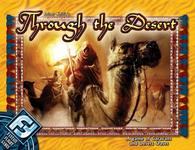

|
Review: Through the Desert - More than Meets the EyeDecember 22, 2005 |

|
When you first open the box of Through the Desert, and see all those pastel camels and severed plastic palm trees rolling around there, you may wonder whether you’ve made a mistaken in picking up Herr Knizia’s own favorite design. Let me reassure you that you have not. In fact, far from it. In this game you will find many hours of engrossing gameplay hidden behind childish-looking pieces and straightforward rules.
First things first, what are you gonna’ get and what’s it gonna’ cost you? Through the Desert comes with 1 game board, 175 plastic camels, 30 plastic riders, 45 watering hole counters, 5 plastic oasis trees, and 40 point chips. The game retails for $29.95. That comes out to be about 17 cents a camel, which may seem a bit steep at first. The components of this Fantasy Flight game may leave something to be desired, particularly the game board, which never lays entirely flat, but what it lacks in presentation, it more than makes up for in gameplay. In the end, I think you’ll find the pastel pieces and clip-on riders somewhat endearing, and part of the game’s charm.
So what are you doing for 45 minutes with all these camels splayed out before you? First, the game setup is pretty quick and painless, and is the only random part of the game (which is my favorite kind of game, increases replayability, but eliminates the role of luck). To setup the game all you have to do is randomly place the watering hole counters on the blue dots, so that the counters with values of 1, 2, and 3 are randomly distributed. Then all that’s left is to reattach the tree tops to their bases and distribute those randomly across the oasis spots. Second, the initial placement involves every play putting down a camel of each color. There are five camel colors (blue, green, yellow, purple, and peach), and every play will be building a caravan in each color. To begin the game everyone starts with one camel in each color, and this initial camel for each caravan is bearing a rider of that player’s color. This initial placement is actually an extremely important part of the game. You need to situate your riders near oases and watering holes. But there’s more involved because the game is really all about developing strong positions in relation to your opponents, so you’ll want to be sure to react to what your opponents do during initial placement. Third, the game proceeds with each player alternating placing two camels (of any colors of their choice) on the board. The rules for camel placement are very simply, and pretty much amount to the fact that you must grow your existing caravans, and not merge them with an opponent’s caravan of the same color.
How do you win this game anyway? The scoring is what really makes this game (as in all Knizia games). There are four different ways to score points, and thus many different strategies for coming out ahead in the end. The four ways to score points involve: 1) claiming water holes, which are worth between 1 and 3 points; 2) linking to oasis trees, which is worth 5 points; 3) enclosing areas, which is worth the number of hexagons enclosed; 4) having the most of a camel color, which is worth 10 points, and up to 50 points if you were to have the most in all five colors. The scores are tallied when any one of the five camel colors runs out. The game length varies because sometimes all players are using a lot of a single color, and other times placement is more evenly distributed across all of the colors.
The key to what makes Through the Desert great lies in the fact that the rules are simple and the playing time is short, but the gameplay is engrossing, interactive, and constantly presents difficult decisions. First, the game is engrossing because downtime is limited. Players can begin planning for their move on other player’s turns, developing contingency plans and the like. Moreover, all that anyone ever has to do on their turn is place two camels. Finally, the actions of other players can affect you significantly, so you’ll always want to be paying attention when others are going. Second, the game is interactive because a lot of the strategy revolves around blocking each other. In many circumstances it might be more worthwhile to prevent your opponent from getting points, rather than getting points yourself. The board is a tight space that quickly becomes congested, and players’ caravans will weave tangled webs, as they feint and counter-feint across the hexagonal desert.
So how many people can you play this with anyway? The game is designed for 2 to 5 players, with slight rules modifications depending on how many players there are. However, the game is at its best with only 2 players. The game works reasonably well with more, but predictability and control decline as the number of players increases, which can make it more frustrating and less strategic. As a head-to-head duel though, the game is an excellent battle of wits to dominate the desert through a variety of scoring methods.
Through the Desert is very deceptive, with its pastel pieces, simple rules, and short playing time, the game may appear to be a light filler, but what you’re really getting is an excellent strategy game that gives players an enormous amount of control, presents them with many difficult decisions, and rewards them with far more than meets the eye.


(See this Review for this article plus additional comments on it)